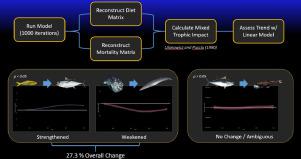Ecological Modelling ( IF 2.6 ) Pub Date : 2021-02-28 , DOI: 10.1016/j.ecolmodel.2021.109509 Matthew S. Woodstock , Tracey T. Sutton , Tamara Frank , Yuying Zhang

|
Ecosystem-based modeling is rapidly becoming an established technique to investigate the health and stability of ecosystems. In the Gulf of Mexico, ecosystem models are applied to neritic systems, but less focus has been placed on the oceanic domain. Since 2011, severe declines have been observed in many micronekton groups that occupy the mesopelagic zone (200 – 1000 m depth). Here we present an ecosystem model for the oceanic northern Gulf of Mexico for the year 2011, simulate that model according to micronekton trends through 2018, and quantify the top-down and bottom-up impacts that each functional group has on one another. These trends were examined to determine whether interactions between the two groups have changed directionally over time. In 2011, zooplankton (trophic level =2) occupied greater than one-third of the total metazoan biomass, and also 40% of the total energy throughput ascended to higher trophic levels in the system. Of the 1849 possible functional group interactions (most of which are indirect), approximately 27% showed significant changes between 2011 and 2018, which were related to shifts in biomass and diet throughout the simulation. Direct top-down interactions changed more frequently than other types of trophic relationships. The frequency of direct changes that occurred in the simulation was not observed evenly among all functional groups, as opposed to indirect interactions. These changes between functional group interactions can be used to further examine potential shifts in the trophic structure of marine ecosystems under various forcing scenarios.
中文翻译:

预警信号:2011-2018年墨西哥洋海湾的营养结构变化
基于生态系统的建模正迅速成为研究生态系统健康和稳定性的一项成熟技术。在墨西哥湾,生态系统模型被应用于神经系统,但对海洋领域的关注较少。自2011年以来,在占据中古生界带(深度200 – 1000 m)的许多微神经元群中,观测到严重下降。在这里,我们为2011年的墨西哥北部海洋提出了一个生态系统模型,根据直至2018年的微浮游生物趋势模拟了该模型,并量化了每个职能组之间的自上而下和自下而上的影响。检查了这些趋势,以确定两组之间的交互作用是否随时间发生了定向变化。2011年,浮游动物(营养水平= 2)占后生动物总生物量的三分之一以上,并且总能量吞吐量的40%上升到系统中较高的营养级。在1849种可能的官能团相互作用中(大多数是间接的),在2011年至2018年之间显示了显着变化,这与整个模拟过程中生物量和饮食的变化有关。自上而下的直接交互比其他类型的营养关系更频繁地更改。与间接交互相反,并未在所有功能组中平均观察到模拟中发生的直接更改的频率。功能组相互作用之间的这些变化可用于进一步检查在各种强迫情况下海洋生态系统营养结构的潜在变化。在1849种可能的官能团相互作用中(大多数是间接的),在2011年至2018年之间显示了显着变化,这与整个模拟过程中生物量和饮食的变化有关。自上而下的直接交互比其他类型的营养关系更频繁地更改。与间接交互相反,并未在所有功能组之间平均观察到模拟中发生的直接更改的频率。功能组相互作用之间的这些变化可用于进一步检查在各种强迫情况下海洋生态系统营养结构的潜在变化。在1849种可能的官能团相互作用中(大多数是间接的),在2011年至2018年之间显示了显着变化,这与整个模拟过程中生物量和饮食的变化有关。自上而下的直接交互比其他类型的营养关系更频繁地更改。与间接交互相反,并未在所有功能组中平均观察到模拟中发生的直接更改的频率。功能组相互作用之间的这些变化可用于进一步检查在各种强迫情况下海洋生态系统营养结构的潜在变化。自上而下的直接交互比其他类型的营养关系更频繁地更改。与间接交互相反,并未在所有功能组中平均观察到模拟中发生的直接更改的频率。功能组相互作用之间的这些变化可用于进一步检查在各种强迫情况下海洋生态系统营养结构的潜在变化。自上而下的直接交互比其他类型的营养关系更频繁地更改。与间接交互相反,并未在所有功能组中平均观察到模拟中发生的直接更改的频率。功能组相互作用之间的这些变化可用于进一步检查在各种强迫情况下海洋生态系统营养结构的潜在变化。









































 京公网安备 11010802027423号
京公网安备 11010802027423号